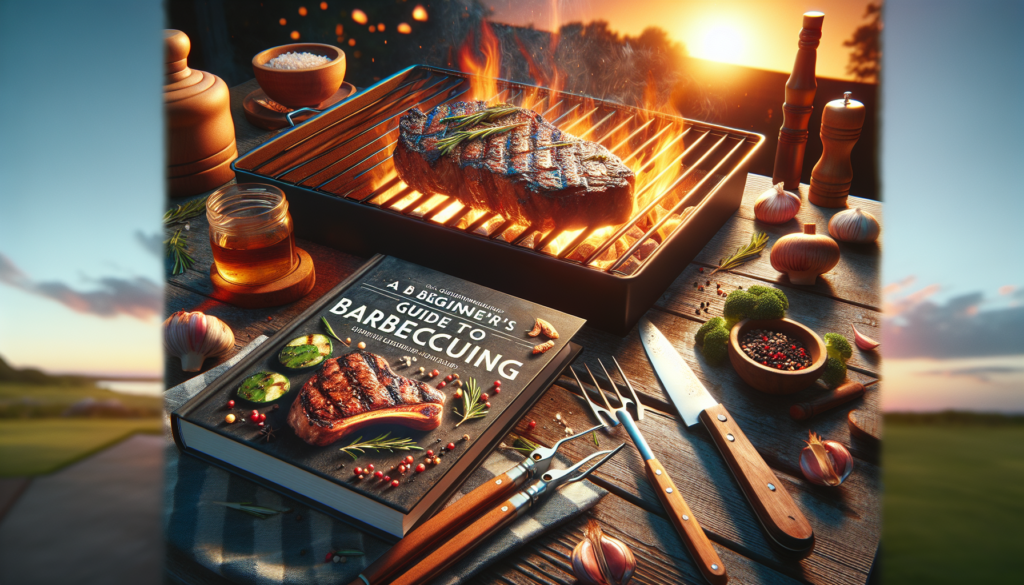So you’ve finally decided to try your hand at grilling, but you’re not quite sure where to start? Look no further! In this article, we’ll provide you with all the essential tips you need to kickstart your grilling journey with confidence. From choosing the right grill to mastering the perfect heat level, you’ll quickly become a grilling pro in no time. So grab your apron and let’s get started on your path to becoming the ultimate BBQ enthusiast!

Choosing the Right Grill
When it comes to grilling, one of the first decisions you’ll need to make is choosing between a charcoal or gas grill. Both options have their advantages, so it ultimately comes down to personal preference.
Charcoal grills offer that classic smoky flavor that many grill enthusiasts adore. They also tend to be more affordable and portable, making them a popular choice for on-the-go grilling. Gas grills, on the other hand, offer convenience and ease of use. With just a push of a button, you can have your grill preheated and ready to go in minutes. They are also known for providing consistent heat, which can be great for cooking delicate foods.
Consider the size and portability of the grill. If you plan on grilling for large gatherings or have a spacious backyard, a larger grill might be the way to go. However, if you have limited space or plan on taking your grill to picnics or camping trips, a smaller, portable grill might be more suitable.
In addition to the basics, there are plenty of additional features to consider when choosing a grill. Some grills come with built-in thermometers, side burners, or even rotisserie attachments. Think about what features are important to you and what will enhance your grilling experience.
Essential Tools and Equipment
To become a grilling pro, you’ll need a few essential tools and equipment. These will ensure that you have everything you need to make your grilling experience smooth and enjoyable.
A grill brush is an important tool for keeping your grill grates clean. It helps remove any food particles or residue from previous grilling sessions, preventing them from sticking to your food.
Tongs and a spatula come in handy for flipping and turning your food. They allow you to handle your grilled items with precision and ease, minimizing the risk of burns.
A meat thermometer is a game-changer when it comes to grilling meat to perfection. It helps you gauge the internal temperature of the meat and ensures that it is cooked to your desired level of doneness.
Grill gloves are a must-have to protect your hands from the heat. They provide a heat-resistant barrier, allowing you to handle hot grates and items on the grill without burning yourself.
Grill baskets are great for grilling small or delicate foods that might fall through the grates. They keep everything contained and make flipping your food a breeze.
Understanding Heat Zones
To master grilling, it’s important to understand heat zones. Different parts of the grill have different temperature levels, and knowing how to utilize these zones can greatly impact your cooking.
Direct heat refers to grilling food directly over the heat source. This is ideal for smaller, thinner cuts of meat or for achieving that beautiful sear on steaks and burgers.
Indirect heat involves cooking food to the side of the heat source, allowing for slower, more controlled cooking. This is perfect for larger cuts of meat that require longer cooking time or for foods that can easily burn.
Setting up multiple heat zones on your grill gives you the flexibility to cook different foods at the same time. By dividing your grill into high, medium, and low heat areas, you can have different temperatures for various cooking needs.
Adjusting the heat levels is crucial to prevent burning or undercooking your food. Whether it’s adjusting the flame on a gas grill or moving hot coals to different parts of a charcoal grill, having control over the heat allows you to achieve the desired results.
Prepping the Grill
Before you start grilling, it’s important to properly prep your grill for cooking.
Cleaning the grill grates is a necessary step to remove any leftover residue from previous grilling sessions. This not only ensures a clean cooking surface but also helps prevent any unwanted flavors or debris from sticking to your food.
After cleaning, it’s a good idea to oil the grill grates. This creates a non-stick surface and helps prevent food from sticking. Simply dip a folded paper towel in a high-heat oil, like vegetable or canola oil, and use tongs to rub it onto the grates.
Once your grill is clean and oiled, preheating is the next step. This allows the grill to reach the desired temperature and ensures consistent cooking. Depending on your grill type, preheating can take anywhere from 10 to 30 minutes.

Choosing the Right Fuel
The fuel you choose for your grill can greatly affect your grilling experience.
Charcoal briquettes are a popular option for charcoal grills. They are easy to ignite and provide a consistent, long-lasting heat. Some charcoal briquettes even come infused with flavorings, such as mesquite or hickory, adding an extra touch to your grilled food.
Hardwood lump charcoal, on the other hand, is a more natural option. It is made from chunks of real wood and burns hotter and faster than briquettes. Hardwood lump charcoal is ideal for achieving that authentic smoky flavor.
For gas grills, propane or natural gas are the most common options. Propane grills are easy to use and provide a steady flame. Propane tanks are readily available and can be easily replaced when empty. Natural gas grills, on the other hand, require a dedicated gas line connection. They offer convenience and eliminate the need for refilling propane tanks.
Preparing the Meat
When it comes to choosing meat for grilling, it’s important to select the right cuts.
For grilled steaks, look for cuts like ribeye, striploin, or tenderloin. These cuts are tender, flavorful, and perfect for that classic steak experience.
When grilling chicken, opt for bone-in, skin-on pieces like chicken thighs or drumsticks. The bone helps retain moisture and adds flavor, while the skin helps protect the meat and adds a delicious crispy texture.
Trimming excess fat from meats is a good practice to prevent flare-ups and ensure even cooking. Fat can cause flames to flare up, charring the meat and potentially causing uneven cooking.
Marinating the meat can enhance its flavor and tenderness. Whether it’s a simple marinade of oil, herbs, and spices or a more complex mixture, marinating allows the flavors to penetrate the meat and elevate its taste.
Seasoning and Spices
Seasoning and spices are the key to taking your grilled dishes to the next level.
Dry rubs are a popular choice for adding flavor to meats. These mixtures typically consist of a combination of herbs, spices, and sometimes sugar or salt. Simply rub the mixture onto the meat before grilling for a burst of flavor.
Wet marinades are another option for infusing meat with flavor. These are typically liquid-based mixtures that can include ingredients like oil, vinegar, soy sauce, and various herbs and spices. Allow the meat to soak in the marinade for a few hours or overnight to let the flavors fully develop.
Don’t underestimate the power of herbs and spices. Adding fresh herbs like rosemary, thyme, or basil, or using spices like paprika, cumin, or chili powder, can significantly enhance the taste of your grilled dishes. Be adventurous and experiment with different combinations to find your signature flavor.
Grilling Techniques
Grilling techniques vary depending on the desired outcome and the type of food being cooked.
Direct grilling is the most common technique, where the food is placed directly over the heat source. This method is great for cooking steaks, burgers, and vegetables that require high heat and quick cooking.
Indirect grilling involves placing the food to the side of the heat source, allowing for slower and more controlled cooking. This technique is ideal for larger cuts of meat, such as roasts or whole chickens, that require longer cooking times.
Smoking is a technique that adds a distinct smoky flavor to your food. It involves cooking the food over low, indirect heat with the addition of wood chips or chunks. This technique is perfect for enhancing the flavor of meats like ribs, brisket, or pulled pork.
Rotisserie grilling utilizes a rotating spit to cook meat evenly and slowly. This technique is great for larger cuts of meat, such as whole chickens or roasts, and ensures juicy and tender results.
Monitoring the Temperature
To ensure perfectly cooked meat, monitoring the temperature is essential.
Using a meat thermometer is the most accurate way to determine the doneness of your meat. Insert the thermometer into the thickest part of the meat, away from any bones or fat, and check the temperature to ensure it reaches the desired level.
Different meats have different ideal temperature ranges for doneness. For example, a medium-rare steak typically ranges between 130-135°F, while a medium-well steak is around 150-155°F. Understanding these temperature ranges will help you achieve your preferred level of doneness.
Avoiding undercooked or overcooked meats is important for both taste and safety. Undercooked meat can harbor harmful bacteria, while overcooked meat can be dry and tough. By monitoring the temperature, you can ensure that your grilled meats are cooked to perfection.
Safety Tips
Grilling can be a fun and enjoyable activity, but it’s important to prioritize safety.
Create a safe grilling area by ensuring that your grill is placed on a stable surface away from any flammable materials. Keep a safe distance from buildings, trees, or other objects that could potentially catch fire.
Using long-handled tools helps you maintain a safe distance from the heat source and reduces the risk of burns. Invest in quality grill tools with sturdy handles to ensure your safety.
It’s crucial to have a fire extinguisher nearby in case of emergencies. Familiarize yourself with how to use it properly and ensure it is easily accessible when grilling. Remember, safety should always be a priority.
By following these tips and techniques, you’ll be well on your way to becoming a grilling expert. Whether you prefer the smoky flavors of a charcoal grill or the convenience of a gas grill, with the right tools and knowledge, you’ll be grilling like a pro in no time. So fire up the grill, invite your friends and family, and enjoy the delicious flavors of your own backyard barbecue. Happy grilling!

